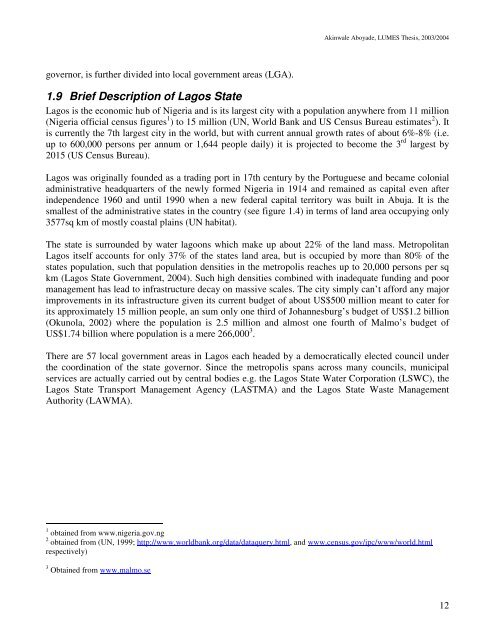Wale Aboyade's thesis - lumes
Wale Aboyade's thesis - lumes
Wale Aboyade's thesis - lumes
Create successful ePaper yourself
Turn your PDF publications into a flip-book with our unique Google optimized e-Paper software.
Akinwale Aboyade, LUMES Thesis, 2003/2004<br />
governor, is further divided into local government areas (LGA).<br />
1.9 Brief Description of Lagos State<br />
Lagos is the economic hub of Nigeria and is its largest city with a population anywhere from 11 million<br />
(Nigeria official census figures 1 ) to 15 million (UN, World Bank and US Census Bureau estimates 2 ). It<br />
is currently the 7th largest city in the world, but with current annual growth rates of about 6%-8% (i.e.<br />
up to 600,000 persons per annum or 1,644 people daily) it is projected to become the 3 rd largest by<br />
2015 (US Census Bureau).<br />
Lagos was originally founded as a trading port in 17th century by the Portuguese and became colonial<br />
administrative headquarters of the newly formed Nigeria in 1914 and remained as capital even after<br />
independence 1960 and until 1990 when a new federal capital territory was built in Abuja. It is the<br />
smallest of the administrative states in the country (see figure 1.4) in terms of land area occupying only<br />
3577sq km of mostly coastal plains (UN habitat).<br />
The state is surrounded by water lagoons which make up about 22% of the land mass. Metropolitan<br />
Lagos itself accounts for only 37% of the states land area, but is occupied by more than 80% of the<br />
states population, such that population densities in the metropolis reaches up to 20,000 persons per sq<br />
km (Lagos State Government, 2004). Such high densities combined with inadequate funding and poor<br />
management has lead to infrastructure decay on massive scales. The city simply can’t afford any major<br />
improvements in its infrastructure given its current budget of about US$500 million meant to cater for<br />
its approximately 15 million people, an sum only one third of Johannesburg’s budget of US$1.2 billion<br />
(Okunola, 2002) where the population is 2.5 million and almost one fourth of Malmo’s budget of<br />
US$1.74 billion where population is a mere 266,000 3 .<br />
There are 57 local government areas in Lagos each headed by a democratically elected council under<br />
the coordination of the state governor. Since the metropolis spans across many councils, municipal<br />
services are actually carried out by central bodies e.g. the Lagos State Water Corporation (LSWC), the<br />
Lagos State Transport Management Agency (LASTMA) and the Lagos State Waste Management<br />
Authority (LAWMA).<br />
1 obtained from www.nigeria.gov.ng<br />
2 obtained from (UN, 1999; http://www.worldbank.org/data/dataquery.html, and www.census.gov/ipc/www/world.html<br />
respectively)<br />
3 Obtained from www.malmo.se<br />
12

















